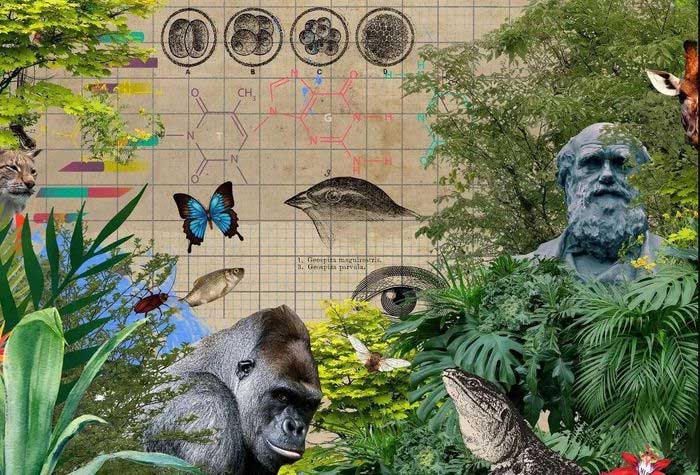On June 7, scientists announced the results of their research on primitive steroids to address the long-standing mystery of how the first complex life forms developed.
Primitive steroids discovered in 1.6 billion-year-old rocks may help scientists unravel the age-old mystery surrounding the evolution of unicellular life. These compounds are produced by eukaryotic organisms, which are cells that contain a nucleus and organelles enclosed within membranes. Modern eukaryotes include plants, fungi, and animals. In contrast, prokaryotic organisms—bacteria and archaea—lack these characteristics. Based on molecular data, researchers know that unicellular eukaryotes first evolved at least 2 billion years ago, but there is very little fossil record of their early existence.
Particularly puzzling is that the steroids produced by eukaryotic organisms as part of their membranes do not appear in the fossil record until about 800 million years ago. The most recent common ancestor of modern eukaryotes (including us humans today) existed on Earth around 1.2 billion years ago, and scientists believe this is the source of the steroids. This misunderstanding has led to confusion regarding why they do not appear in ancient rocks.
Now, researchers have discovered that they were searching for the wrong thing. Instead of looking for steroid compounds with the characteristics we see today, they found precursors from the early stages of bacterial metabolism. The research team published their findings on June 7 in the journal Nature.

Life evolved from unicellular organisms to the diverse forms we see today.
The lead author of the study, Jochen Brocks, a professor at the School of Earth Sciences at the Australian National University, stated, “It (primitive steroid) is like something that should be obvious and present every day, but we don’t ‘see’ it. But once we know what it looks like, we suddenly see it everywhere.”
The Eukaryotic Realm
After researchers identified which molecules to look for, they found them across various sedimentary rocks aged between 1 billion and 1.6 billion years. Brocks mentioned that this shifts the narrative regarding what researchers believed about the initial abundance of eukaryotes (comprising the three kingdoms: animal, plant, and fungi).
He said, “Previously, we thought that eukaryotes were very sparse or limited to marginal environments where molecular fossils could not be found. Now it seems that more primitive forms could be quite abundant even in offshore habitats.”
The compounds were first found in rocks formed on the ancient ocean floor, which have been exposed on land in northern Australia. However, as researchers expanded their search for billion-year-old rocks globally, they discovered traces of ancient steroids from various locations worldwide, including West Africa, Scandinavia, and China.
The oldest samples date back 1.64 billion years; scientists have yet to find older rocks preserved well enough for analysis. Additionally, Brocks noted that their data still has a temporal gap in the period from 800 million to 1 billion years ago, as there are very few marine rocks from that time that still exist. However, this period coincides with the time when modern eukaryotes likely began to emerge. Therefore, it is crucial to fill these gaps to resolve all uncertainties.
A Turning Point in the Evolution of Organisms
Laura Katz, a biologist at Smith College who studies the evolution of eukaryotes but was not involved in the research, stated that this new discovery is a “significant step forward” in supplementing the missing data about early eukaryotes.
Katz remarked, “This scientific report is helping us understand what early eukaryotes might have looked like.”
Andrew Roger, a molecular biologist at Dalhousie University in Canada, who also did not participate in the study, added that these organisms evolved in a very different environment compared to today. Roger noted that Earth’s atmosphere did not contain significant levels of oxygen until about 2.4 billion years ago and did not reach current oxygen levels until about 650 million years ago.
He stated, “Oxygen levels in the atmosphere could play an important role in the timing of eukaryotic evolution, as most eukaryotes use oxygen in their metabolic processes. Katz even suggested that the development of new steroids may have allowed early eukaryotic organisms to move into new oxygen-rich environments.”
This represents a breakthrough step from unicellular organisms evolving into multicellular ones, into animals, and eventually into humans. It is noteworthy that the evolution from ape to human took just over 3 million years, while the evolution from unicellular to multicellular organisms took billions of years.
Steroids are a type of organic compound characterized by a specific arrangement of four cycloalkane rings bonded together. Examples of steroids include dietary cholesterol, the sex hormones estradiol and testosterone, and the anti-inflammatory drug dexamethasone. The core of a steroid consists of 20 carbon atoms bonded together in the form of four fused rings: three cyclohexane rings (referred to as rings A, B, and C) and one cyclopentane ring (ring D). Steroids differ based on functional groups attached to the core of the four rings and the oxidation of the rings.
Steroids are organic compounds that are either naturally occurring or synthetic, with a structure of 17 carbon atoms arranged into four rings and include sterols and bile acids, adrenal hormones, and sex hormones. Some naturally occurring steroids include compounds like digitalis and precursors of certain vitamins.




















































